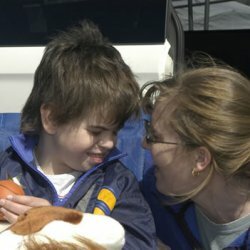Tourette's syndrome: causes, symptoms, treatment

It should be said that Turret spent many years on research, he first identified two key signs of the syndrome - echolalia and coprollation, as a result, it became clear that these symptoms are most often found in boys. This led to a very serious conclusion that the disease is transmitted genetically, however, gene studies were not yet done and this painful gene was not known. At the same time the doctor thought about what triggers the mechanism of the onset of the disease, modern medicine affirmatively agreed with the dopaminergic hypothesis. A number of studies have shown that the mechanism that triggers this process with unnatural behavior and convulsions is dopamine.
Another important study that was conducted by Turret was the observation of tics, they were of different lengths in time and arose with varying strengths. Among the general picture, there were tick marks that belonged to one group of muscles and, at the same time, appeared the same way, the doctor described in detail how they passed, and also what they expressed.
It is noteworthy that in the case of Turret syndrome, both the first and second signs can manifest themselves and be expressed with varying frequency and to varying degrees. Among the many manifestations there are those that patients with time can learn to control, in certain places and situations. But then at home or in a relaxed state these manifestations come out again.
The established causes of the Turret syndrome
There are no exact causes of the syndrome to this day, but it is 100% known that the disease is transmitted and developed at the genetic level. Nowadays, it has been suggested that even a healthy parent can have a child with a syndrome because of our ecology. Disease can develop during gestation due to genetic malfunction. Scientists around the world are working on this problem and are looking for a gene responsible for triggering the syndrome.
Symptoms of the syndrome
Syndrome manifests itself in ticks, they are divided into motor and vocal.
Motor tics are of a complex and simple type. Simple tics differ in their ease and pass quickly, with simple tics only one muscle group is involved, usually it happens to the face. Surely many people have noticed this, the rapid blinking of the eye or the jerking of the lips, the unnatural grimace of the face or lips, the jerking of the shoulder or the shaking of the hand, sudden movements of the head or frequent inhalations of the nose are also noted. It is worth noting the contraction of the abdominal muscles, unnatural contractions of the joints of the fingers, sudden ejection of the legs forward in the course of movement. In continuation of the symptoms, one should note the reduction in one line of the eyebrows and frequent frowning, clattering with teeth and clicking of the jaw.
As for complex motor tics, it is also worth noting grimaces of more complex species, sudden bouncing and unwanted touching objects and bodies. There are such disorders, when a person himself is unwilling to harm himself: hit his head, bite his lip and stuff.
Vocal tics are expressed by speech disorders, words with no meaning or just sounds appear in the speech, as well as long, absurd actions like whistling, frequent coughing, clicking with your mouth or mooing. Sometimes it looks very unpleasant, when a person seems to be speaking correctly, and then such a sound appears, from the outside it looks like a mental deviation.
In turn, vocal tics are complex when long, awkward combinations of words are pronounced. In a speech they are not at all the topic, when a person can not cope with such an insertion of combinations, this is called echololia. In such cases, the patient needs comprehensive help from a speech therapist and neurologist. Some words with this form of the syndrome are not pronounced at all.
The coprolalia described in the beginning also refers to this series, only here involuntarily there is a cry of foul language, but it is not addressed to an individual. Often this happens as a seasonal and temporary attack.
Diagnosis and Stages of Turret Syndrome
Diagnosis is appropriate if there are explicit vocal or motor tics. Given that the syndrome manifests itself at the genetic level, it is most often detected in early childhood. Children can not and do not like to control incomprehensible movements, so it is easier to identify such tics, when a person grows up, he starts to hide it. When diagnosed with Tourette's syndrome, stages are necessarily established, the stages are evaluated according to the following criteria: severity, duration and frequency of tics, their nature, how they affect human behavior among people. Also necessarily take into account somatic abnormalities, psyche, learning ability and ability to work.
The first stage is accompanied by tics rarely, for example, once in a couple of minutes a tick appears. As a rule, these are easy and inconspicuous tics, often the patient knows how to hide them well and they do not strain him in life, knowing the time of the appearance of a tick, a person can make some camouflage. In this case, you do not need to use drugs.
The second stage creates a big problem with ticks, becauseThey appear 2-4 times per minute, of course, this frequency is noticeable to people, but many patients are able to mask even the tics of the second stage. However, such a disguise requires a lot of strength and constant care, which in itself becomes noticeable, they look alarmed and wary, tk. Constantly expect the appearance of a tick. There is a lack of attention to others, and sometimes it looks like hyperactivity.
The third stage is even more complicated - from five ticks per minute. In the third stage, vocal and motor tics are noted, can be mixed and to varying degrees. Control in this stage is almost impossible, people perceive such people for mentally ill, meanwhile they do not lag behind in development. Of course, at this stage, communication with others is extremely complicated, patients have a lot of complexes, many jobs for them are closed, although they can work very well for mental development. For this reason, in addition to the syndrome, there are also mental abnormalities, a complex of uselessness and rejection, they become isolated, and often treatment with drugs is needed.
The fourth degree is the most extreme and complex, in this case the tics are so frequent that it seems as if they are constant, the control of tics is completely absent. At this stage, a lot of mental abnormalities and without drug intervention can not do.
Methods of treatment of Turret syndrome
Completely cure the syndrome is very difficult, depending on the stage, you can achieve some improvements. It is very difficult to take into account the variety of tics and problems associated with this, while choosing the drug. A number of doctors should be examined: an oculist, a neurologist, a pediatrician and a psychiatrist, then put together the resulting picture.
The problem is complicated by the fact that you need to watch for a long time muscles and the appearance of a tick, this is necessary to find the main muscle group that is responsible for the tick. Also, the human factor is important, the patient should fully trust the doctor and not be ashamed of ugly details of the disease.
The methods of treatment, of course, depend on the degree of the syndrome. The first degree excludes medicines, but 2, 3 and 4 degrees can take depressive states, psychoses and will need to implement a course of rehabilitation. To somehow calmed the tics, a number of preparations based on benzodiazepine are used, such as: phenazepam, diazepam, clonazepam, lorazepam. And also drugs adrenomimetiki: catapress and clonidine. Necessarily need antipsychotics: olanzapine and tiaprid, if the tics do not bother much, then you can use light medications baclofen and phenibut, in more difficult moments, haloperidol, fluorophenazine and pimozide.
It is worth knowing that these drugs are not harmless, they have different side effects, you can use them with other drugs only on the advice of a doctor with a restriction on the number. Most of them do not combine with driving vehicles, cause drowsiness and apathy. These drugs can be bought on prescription and used only as prescribed by the doctor.
Modern medicine has found a way of treating Turret syndrome with the help of surgical intervention, more precisely, the installation of a neurostimulator. Nevertheless, this is still the initial stage, there are no stable results, some types of syndrome appear again.



